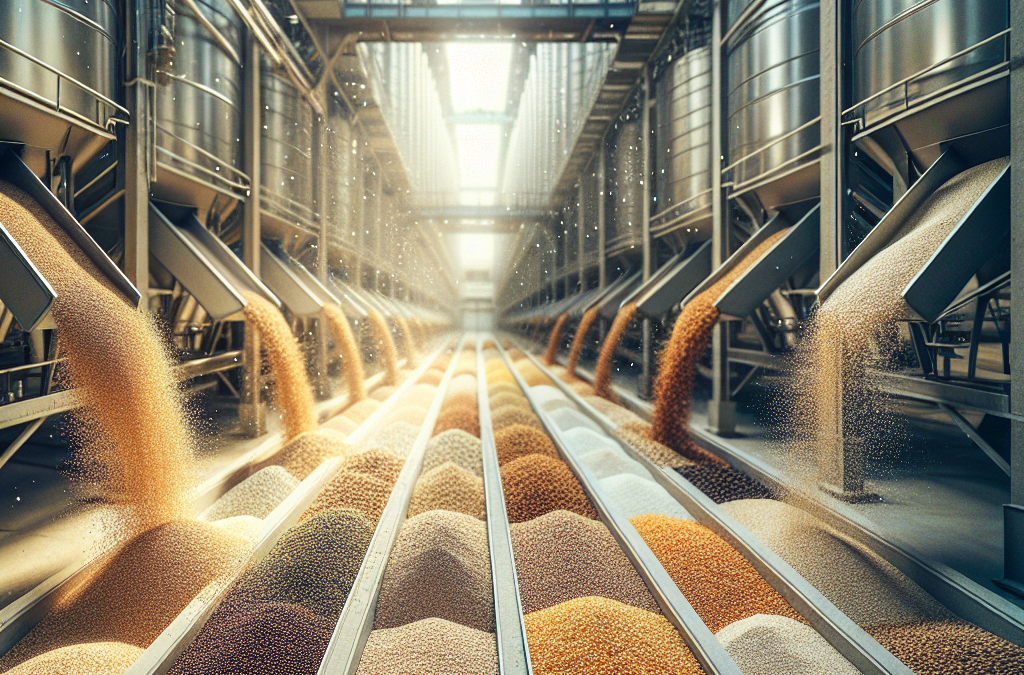Why Proper Grain Storage Matters
Understanding Grain Quality
So, let me tell you, when it comes to grains, quality is key—especially for us vegans. If our grains go bad, not only do we lose out on crucial nutrients, but we also risk introducing harmful bacteria into our diets. Quality grain storage helps prevent spoilage and ensures every meal is packed with nutritional goodness.
I’ve learned the hard way how bad storage can ruin a good batch of quinoa or lentils. When grains absorb moisture and pests come knocking, you’d be surprised how quickly things can go downhill. This is why I always make it a point to keep an eye on the conditions of my storage.
Embracing proper storage techniques can completely transform your vegan meals. With high-quality grains, you’re not just filling your belly; you’re nourishing your body. Let’s dive into how to achieve that!
Different Storage Methods
First things first, you’ve got options! There are several effective methods to store grains, depending on the type and quantity you have. Airtight containers are my go-to; they lock in freshness and protect against pests. Plus, they look pretty neat lined up in the pantry!
If you’re dealing with larger quantities, consider vacuum sealing. I tried this with beans and lentils, and wow—talk about freshness! This method removes air from the packaging, which means a longer shelf life and a quality guarantee.
Temperatures matter too. Keeping grains in a cool, dark place is essential. Your kitchen might be cozy, but I’ve had to clear out a little nook in my cool basement just for my grains to prevent them from breaking down over time.
The Role of Air and Light
I often overlook this, but air and light are two sneaky enemies of grain storage. Grains need a stable environment, devoid of air exposure and sunlight, which can lead to rancidity. I learned this the hard way with some oats that turned stale way too soon.
When I started storing grains in opaque containers, completely sealed from the light, I saw a dramatic difference. My grains stayed fresher longer, and I wasn’t wasting any more precious food!
Paying close attention to light and air might seem trivial, but trust me, it’s worth it for our beloved grains. After all, fresh grains are more than just ingredients; they’re the heart of our meals.
The Best Containers for Storing Grains
Glass vs. Plastic
When it comes to choosing containers, I’ve tried both glass and plastic, and each has its pros and cons. Glass containers are phenomenal for storing grains. They don’t absorb odors or stains, and they give me peace of mind that my food is kept clean and uncontaminated.
But let’s be real—glass can break! When I’m feeling adventurous, I go for sturdy plastic containers. They’re lightweight and less prone to shattering, making them ideal for my busy kitchen adventures.
Ultimately, I mix and match based on what I have at the moment. The key here is finding containers that can seal tight! Whether it’s glass, plastic, or even tin, airtight is what we’re shooting for.
Specialty Grain Storage Bags
Now, I came across some specialty grain bags that are designed specifically for storing grains. These bags made from breathable fabric keep my grains fresh while allowing them to “breathe.” It’s like giving them a little oxygen without that pesky excess air!
Surprisingly, I found that these bags are incredible for larger volumes of grains. They are easy to stack, and since they breathe, they help prevent moisture buildup. Who knew storage could be stylish?
After using these grains bags for a while, I’ll never go back to basic storage. They’ve really become a staple in my kitchen, and if you value your grains like I do, you should give them a shot!
Labels and Organization
Okay, let’s chat organization. I’m a little obsessed with keeping things tidy! One of the best tips I picked up was to label everything. Nothing is worse than pawing through my pantry trying to find that elusive bag of millet. So now, each container and bag has a label with the grain name and the date I stored it!
Creating an inventory can make a world of difference. I’ve started keeping a little spreadsheet to track what I have and what needs using up first. It’s kind of like a game to see how long I can make my grains last.
With a little organization, I use up my grains before they go stale. And let’s be honest—a little kitchen organization goes a long way in making cooking more enjoyable!
Get Whole Wheat Flour, Grains and Milling Supplies – CLICK HERE
Maintaining Nutritional Value
Pest Prevention Strategies
Alright, let’s address the not-so-fun topic of pests. Trust me, nothing ruins the grain game like opening up a bag of grains to find little critters having a party. To combat this, I always freeze my grains for a couple of days before transitioning them to their permanent storage. This gives any potential pests the ol’ one-two punch!
I also love using bay leaves—seriously, they do wonders for deterring moths and beetles. I just tuck a couple of leaves into each container. It’s a simple step, but it definitely helps keep things critter-free!
Don’t forget to regularly check your stored grains and do a little housekeeping. If something looks a little off, it’s best to err on the side of caution—safety first, right?
Regularly Checking for Freshness
Now, freshness is key. I make it a habit to check my grains every few months (more often for things like nuts, which can go rancid pretty quickly). Smelling and tasting are my trusty friends for this. If something seems funky, it’s time to toss it.
Being proactive has made it way easier to keep my meals tasty and nutritious. I mean, who wants to cook with stale grains? Not me! Regular checks keep my pantry lively and my meals delicious.
It’s amazing how little responsibilities, like checking for freshness, can have big payoffs over time!
Cooking Techniques to Maximize Nutritional Value
Finally, let’s talk cooking techniques! I’ve learned that certain cooking methods can help maintain or enhance the nutritional value of grains. For instance, soaking grains overnight not only makes them easier to cook but can also boost their nutrient availability. I love prepping things the night before; who doesn’t appreciate an early start?
I’ve also experimented with sprouting some grains, and it’s a game-changer! Sprouting boosts vitamin content and makes them fuller in flavor. Plus, it feels super rewarding when I can say my meal is homegrown in a way!
All these cooking tips just add to the incredible power of proper grain storage. When you take care of your grains, they take care of you by delivering optimal nutrition day in and day out.
Final Thoughts on Grain Storage
A Well-Stocked Pantry
Getting your grain storage right is more than just a chore; it’s an essential part of your vegan lifestyle. Having a well-stocked pantry means you’re always ready to whip up nutritious meals at a moment’s notice. Plus, knowing your grains are fresh gives you peace of mind!
From quality storage to healthy cooking methods, every little step counts. And while it might seem daunting to dive into, once you get the hang of it, it becomes second nature.
So, let’s raise our glasses of oat milk to well-stored grains! Not only do they make our meals delicious, but they also play a vital role in our health journeys as vegans.
FAQs
1. How long can grains be stored safely?
Grains can typically be stored for 6 months to a year if kept in airtight containers in a cool, dry place. However, check for freshness regularly!
2. What’s the best way to store grains to prevent pests?
Freezing grains for a few days upon purchase can help kill any potential pests. Also, using bay leaves in storage helps deter bugs!
3. Should I wash grains before storing them?
It’s not necessary to wash grains before storing, as moisture can lead to spoilage. Rinsing them before cooking is usually enough.
4. Are glass containers better than plastic for storing grains?
Glass containers tend to be better for long-term storage, as they don’t absorb odors, but sturdy plastic options are also great for practicality.
5. How do I know if my grains are still good to eat?
Check for any strange odors, off colors, or signs of insects. If they seem stale or smell weird, it’s safer to toss them out.
Get Whole Wheat Flour, Grains and Milling Supplies – CLICK HERE
Related Content
Auto Amazon Links: No products found.





